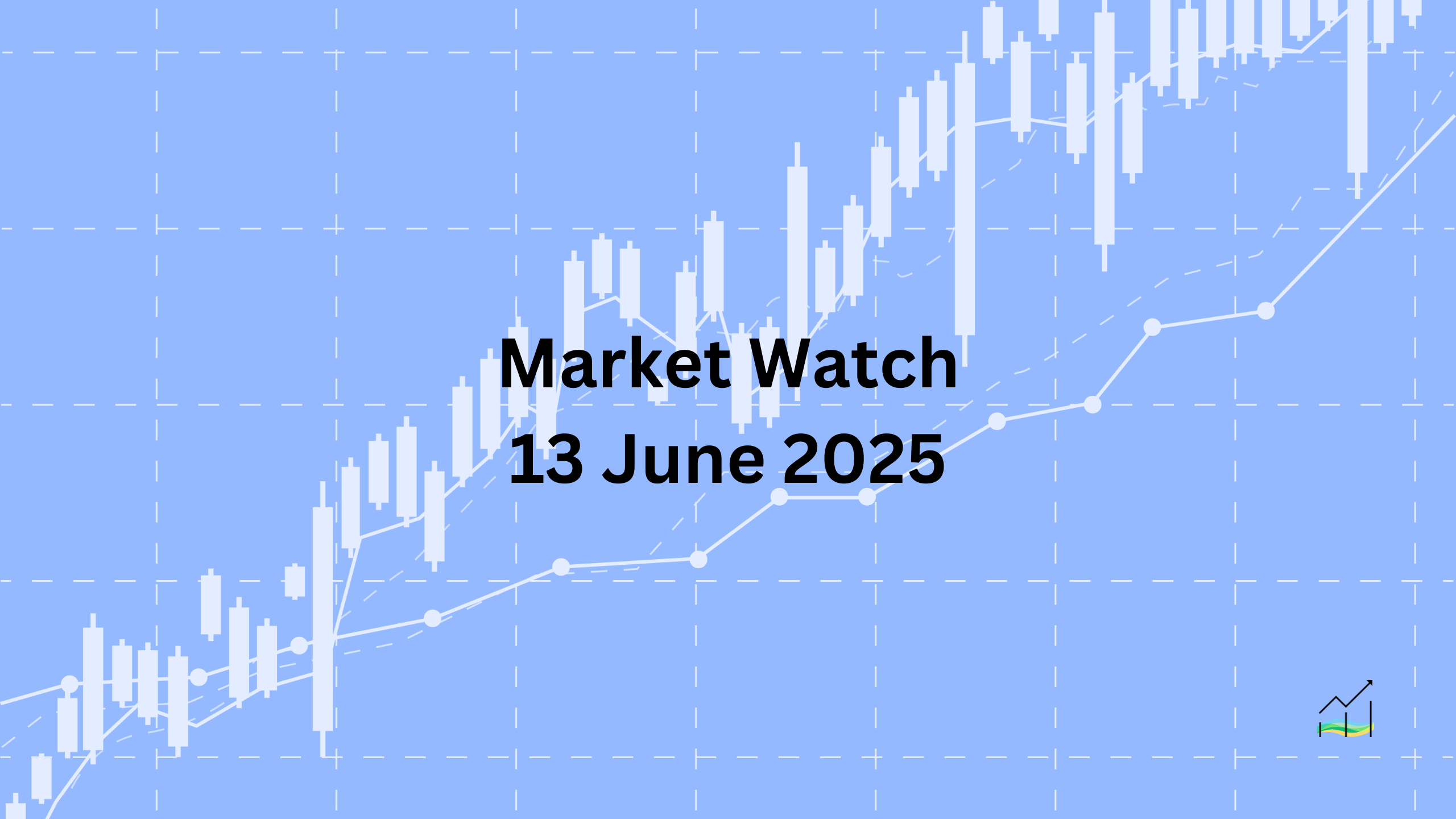13/06/2025 Market Watch

Israel Strikes Iran, Oil & Gold Surge
Key Takeaways:
- Israel launched a direct strike on Iran’s nuclear program, reportedly targeting scientists and IRGC leadership.
- The US was informed but not involved, distancing itself from the action.
- The dollar rose modestly across the board, but safe haven credibility is being questioned.
- Global equities declined sharply, with Europe hit the hardest.
- Bonds failed to rally, gold rose above 1%, and oil surged over 7%.
Geopolitical tensions surged over the weekend after Israel launched an airstrike on Iran’s nuclear enrichment site, reportedly targeting key scientists and senior Revolutionary Guard officials. Despite the scale of the operation, no rise in radioactivity was detected. The US confirmed it was informed of the attack in advance, but clarified it did not authorize or participate in the strike. Market reaction was swift, with a flight to safety visible in commodities but not in traditional haven assets.
The US dollar is stronger across all G10 currencies and most emerging market counterparts, though the gains have been limited. This restrained response has reignited questions about the dollar’s reliability as a safe haven in a time of geopolitical stress. Equities, meanwhile, faced broad declines. European stock indices fell by as much as 1.5%, while US index futures showed similar weakness. Asian markets, although affected, saw milder losses.
Bond markets have not shown the typical defensive reaction. Yields on 10-year European government bonds edged 2 to 4 basis points higher. In contrast, the 10-year US Treasury yield dipped slightly to around 4.35%. Gold, which the ECB recently noted has overtaken the euro as the second most important reserve asset, climbed over 1%, trading near $3386. Crude oil saw the most significant move, with WTI futures jumping more than 7.5% to trade near $69, reflecting fears of wider regional instability and potential supply disruptions.
United States of America
Overview
Following Israel’s airstrike on Iran, the US Dollar Index regained ground after falling to a new three-year low near 97.60 in early North American trade the day before. The recovery has been limited, with the index unable to surpass the previous session’s high near 98.50. This modest rebound has sparked renewed doubts about the dollar’s role as a safe haven, although it is too early to draw firm conclusions.
Attention today turns to consumer sentiment, with the preliminary University of Michigan report expected to show a modest increase in confidence and a slight decline in inflation expectations. Historically, this survey held more weight in the Federal Reserve’s tightening cycle, especially under Chair Powell. Its influence has since diminished, with the New York Fed’s data offering less concerning signals in recent releases.
Inflation expectations are also being assessed through market-based measures. The one-year breakeven rate, derived from the spread between nominal and inflation-protected securities, is hovering near 2.50%, the lowest level so far this year. The 5-10 year breakeven rates are also subdued, trading around 2.30%, suggesting a stable medium-term inflation outlook.
Economic Drivers
- Geopolitical tensions following Israel’s strike on Iran supported the dollar’s rebound.
- Renewed scrutiny over the dollar’s safe haven status amid limited follow-through in gains.
- Anticipated improvement in consumer sentiment and a slight decline in inflation expectations.
- Reduced policy significance of the University of Michigan survey compared to earlier Fed tightening phases.
- Market-based inflation measures indicate declining short-term and stable long-term expectations.
Data and Events
- 13 June 2025: 30-y Bond Auction.
- 13 June 2025: Prelim UoM Consumer Sentiment.
- 13 June 2025: Prelim UoM Inflation Expectations.
Price Action
- The Dollar Index recovered from a three-year low near 97.60 but failed to break above 98.50.
- Consolidation below resistance suggests indecision about its safe haven credibility.
Key Points:
- Dollar rebounded after geopolitical escalation, but upside momentum stalled.
- Today’s focus is on the University of Michigan sentiment data.
- Inflation expectations are softening, with market breakevens showing a subdued outlook.
- Safe haven narrative around the dollar remains uncertain.
Canada
Overview
The Canadian dollar strengthened early in the week as the US dollar fell to its lowest level against the loonie since October, briefly dipping below CAD1.3600 before stabilizing. This movement came before the Israeli airstrike on Iran, after which the US dollar rebounded slightly to around CAD1.3650 and then entered a consolidation phase. Despite the market volatility, domestic Canadian data has had little influence on price action.
Today’s economic calendar includes updates on manufacturing sales, wholesale trade, and capacity utilization. These reports typically carry limited market impact, even in more stable conditions. Looking ahead, next week’s releases will include April’s portfolio investment flows and retail sales figures, which could offer clearer insights into consumer activity and foreign investor sentiment.
Market pricing continues to reflect expectations of only one more interest rate cut by the Bank of Canada by year-end. This aligns with the broader view that the current easing cycle is nearing its conclusion, especially with inflation pressures gradually stabilizing.
Economic Drivers
- US dollar weakness led to a CAD rally before geopolitical tensions triggered a partial reversal.
- Domestic economic data remains secondary in market impact.
- Expectations of just one more rate cut from the Bank of Canada suggest the easing cycle is nearing an end.
- April retail sales and portfolio flows due next week may carry more significance.
Data and Events
- 13 June 2025: Capacity Utilization Rate.
- 13 June 2025: Manufacturing & Wholesale Sales.
Price Action
- USD/CAD reversed lower from around 1.3730, hitting a low near 1.3600 before bouncing.
- Price briefly dipped below 1.3600 ahead of the Israeli strike but recovered toward 1.3650.
- Current consolidation suggests indecision after recent volatility.
Key Points:
- Canadian dollar rose to multi-month highs before retreating.
- Domestic data today is low-impact, focus shifts to next week’s releases.
- Market sees one more Bank of Canada cut by year-end.
- Price action remains sensitive to global developments and USD movements.
Europe
Overview
The euro touched its highest level since October 2021, reaching around $1.1630 in early North American trade. However, following Israel’s military strike on Iran, the euro was sold off sharply and retreated to approximately $1.1510. It has since remained above yesterday's low near $1.1485. The broader move reflects geopolitical risks overshadowing what had been a strong short-term rally.
Economic data released this week showed clear signs of weakening momentum. Industrial production in April contracted by 2.4%, and the trade surplus was cut in half to 14 billion euros, down from a record 29 billion euros in March. These figures are consistent with expectations of a return to modest growth, following a robust 0.6% quarter-over-quarter expansion in Q1 2025, which had matched the strongest performance since Q2 2022.
Looking ahead, growth forecasts for Q2 and Q3 2025 have been revised down to 0.1% quarter-over-quarter, suggesting a stall in the eurozone’s recovery. Rate cut expectations have begun to build, with the swaps market pricing in a small chance of a cut in July, rising to nearly 60% by September and almost fully priced in before the end of the year.
Economic Drivers
- The euro briefly surged to a multi-year high before geopolitical tensions reversed gains.
- Industrial production contracted 2.4% in April, reflecting manufacturing weakness.
- The trade surplus halved from March’s record level, indicating external headwinds.
- Q1 growth was strong at 0.6%, but Q2 and Q3 forecasts have been downgraded to 0.1%.
- Markets are increasingly pricing in policy easing from the European Central Bank.
Data and Events
- 13 June 2025: German & French Final CPI.
- 13 June 2025: Eurozone Industrial Production.
- 13 June 2025: Eurozone Trade Balance.
Price Action
- Euro peaked at $1.1630, its highest since October 2021.
- Declined to around $1.1510 following Israel’s strike, with support near $1.1485.
- Price remains above yesterday’s low, signaling short-term resilience despite geopolitical shocks.
Key Points:
- Euro hit a 3-year high before retreating on Middle East escalation.
- Economic data reflects slowdown in industrial activity and external trade.
- Market expectations point to rate cuts by the ECB later this year.
- Near-term direction remains sensitive to geopolitical and macroeconomic shifts.
Japan
Overview
The yen saw renewed volatility this week as the dollar reversed lower after reaching a monthly high near JPY145.45. It dropped to nearly JPY143.20 on Thursday and briefly fell further to around JPY142.80 following Israel’s strike on Iran. By the European morning, the dollar rebounded toward JPY144, reflecting broader risk sentiment and shifting interest rate dynamics. Notably, the rolling 30-day correlation between the dollar-yen pair and US 10-year yields has risen to over 0.40, the highest in around two months, suggesting a re-coupling of traditional macro drivers.
On the domestic front, economic data continues to reflect softness. Japan’s Q1 GDP contraction was revised from an annualised -0.7% to -0.2%, a less severe decline, but Q2 has started on a weaker footing. April industrial output was revised lower to a 1.1% drop, and while the services sector (tertiary index) may have posted a 0.3% gain, this follows a steeper-than-expected decline in March. These indicators point to a fragile recovery, despite ongoing inflationary pressures.
Next week’s Bank of Japan meeting is not expected to result in a rate hike. Instead, attention is turning to its approach on bond purchases. The central bank has already slowed its JGB purchases, which may be contributing to long-end yield volatility. It is now reportedly considering smaller reductions from the current pace of JPY400 billion per quarter. Some analysts suggest this could be halved to JPY200 billion. As of March, the BOJ’s balance sheet stood at 118% of GDP, its lowest since May 2020 and well below its 2022 peak of 133%.
Economic Drivers
- Dollar-yen correlation with US 10-year yields is rising again, signaling macro re-alignment.
- Q1 GDP revised to a smaller contraction at -0.2%, though Q2 indicators are soft.
- Industrial output in April revised lower to -1.1%, showing weakness in manufacturing.
- Tertiary industry index may have edged higher by 0.3% in April after a steeper March decline.
- BOJ is shifting focus from rates to bond purchase strategy, considering a slower taper pace.
- BOJ’s balance sheet has shrunk to its lowest GDP ratio since 2020.
Data and Events
- 13 June 2025: Revised Industrial Production.
- 13 June 2025: Tertiary Industry Activity.
Price Action
- USD/JPY reversed from JPY145.45, dropping to JPY143.20 and briefly to JPY142.80.
- Recovered toward JPY144 in the European session.
- Increased correlation with US yields could drive future direction.
Key Points:
- Yen strengthened on geopolitical tensions but remains volatile.
- Economic indicators suggest Q2 growth remains fragile.
- BOJ unlikely to change rates, but bond purchase plans are under review.
- Rising yield correlation may reassert macro influences on yen movement.
© 2025 SKONE Enterprise (003319453-V). All rights reserved.
The content on this site is for informational purposes only and does not constitute financial advice.


